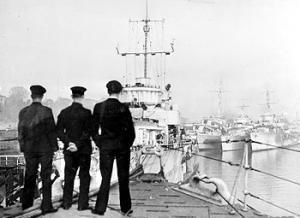HMS Ferret (shore establishment 1940)

Three sailors view numerous destroyers of the escort group B7, which are moored alongside each other after returning home to Londonderry, Northern Ireland from a patrol in the north Atlantic. Identifiable vessels include HMS Versatile, HMS Godavari, HMS Vanessa, HMS Vidette and HMS Rochester.
|
|
| History | |
|---|---|
|
|
|
| Name: | HMS Ferret |
| Commissioned: | 9 December 1940 |
| Decommissioned: | 21 June 1947 |
| Fate: | Decommissioned, re-established as HMS Sea Eagle |
| General characteristics | |
| Class and type: | Stone frigate |
HMS Ferret was a shore establishment and naval base of the Royal Navy during the Second World War, located in Derry. It was given a ship's name as a stone frigate.
With the outbreak of the Second World War and the start of the Battle of the Atlantic, the Admiralty decided to develop a large new naval base in Northern Ireland to serve as a base for convoy escorts, providing repair and refuelling facilities. Derry was selected as a prime location due to Londonderry Port being the UK's most westerly port it provided the fastest access into the Atlantic. Royal Navy warships could then quickly come to the aid of convoys under attack by German U-boats, and help to escort the convoys in and out of British ports.
Part of Ebrington Barracks was handed over to the Royal Navy in mid-1941 and the entire barracks came under Admiralty command in 1943 as RN Barracks Ebrington, part of the Londonderry shore base known as HMS Ferret. The old North of Ireland shipyard at Pennyburn was also taken over to be used as a ship repair facility, manned by workers from the Harland and Wolff yard at Belfast. Ships based at Ferret were under the operational control of Western Approaches Command, located in Plymouth for the early part of the war. The main headquarters for the Western Approaches Command was moved to Liverpool in February 1941 as the North Western Approaches became the most vital area of convoy activity.Ferret was then the backup for the Liverpool headquarters, with the other main bases in the area being at Greenock, and later at Belfast. The organisational function of Ferret was to form escort groups of the warships based there, mostly small destroyers, frigates, corvettes and armed trawlers. From 1 February 1941 these craft had a separate accounting system from the main base. By 1942 this system had been extended to handle the accounts of Royal Navy ships based at St' John's and Argentia. A Coastal Forces base was established in April 1941, under the name HMS Ferret II.
...
Wikipedia
